Europe, British Isles, North-East England, County Durham, Durham [Map]
Durham, County Durham is in County Durham.
1069 Murder of Robert de Comines Earl Northumbria
1346 Battle of Neville's Cross
Anglo-Saxon Chronicle. 1068. This year King William (age 40) gave Earl Robert the earldom over Northumberland; but the landsmen attacked him in the town of Durham, County Durham [Map], and slew him, and nine hundred men with him. Soon afterwards Edgar Etheling (age 17) came with all the Northumbrians to York; and the townsmen made a treaty with him: but King William (age 40) came from the South unawares on them with a large army, and put them to flight, and slew on the spot those who could not escape; which were many hundred men; and plundered the town. St. Peter's minster [Map] he made a profanation, and all other places also he despoiled and trampled upon; and the etheling (age 17) went back again to Scotland. After this came Harold's sons from Ireland, about midsummer, with sixty-four ships into the mouth of the Taft, where they unwarily landed: and Earl Breon came unawares against them with a large army, and fought with them, and slew there all the best men that were in the fleet; and the others, being small forces, escaped to the ships: and Harold's sons went back to Ireland again.
On 28 Jan 1069 Robert de Comines Earl Northumbria was burned to death in Durham, County Durham [Map] when a rebel army set fire to the house in which he was staying. All his men were killed. In retaliation King William "Conqueror" I of England (age 41) commenced the Harrying of the North.
On 17 Oct 1346 at the Battle of Neville's Cross near Durham, County Durham [Map] the English inflicted a heavy defeat on the Scottish army that had invaded England in compliance with their treaty with the French for mutual support against England.
The English army included: William Deincourt 1st Baron Deincourt (age 45), Henry Scrope 1st Baron Scrope Masham (age 34), Ralph Hastings (age 55), Ralph Neville 2nd Baron Neville of Raby (age 55), Archbishop William Zouche, Henry Percy 10th and 2nd Baron Percy (age 45) and John Mowbray 3rd Baron Mowbray (age 35).




Of the Scottish army King David II of Scotland (age 22), John Graham Earl Menteith and William "Flower of Chivalry and Knight Liddesdale" Douglas 1st Earl Atholl (age 46) were captured and imprisoned in the Tower of London [Map].
Neil Bruce, John Randolph 3rd Earl Moray (age 40), David Hay 6th Baron Erroll (age 28) and Edward Keith of Sinton (age 66) were killed.
After 17 Oct 1346 Ralph Hastings (age 55) died at Durham, County Durham [Map].
On 20 Jul 1405 John Fauconberg was beheaded in Durham, County Durham [Map].
In 1423 Malise Graham 3rd Earl Strathearn 1st Earl Menteith (age 16) was sent to Durham, County Durham [Map] as one of the hostages for the safe return of King James I of Scotland (age 28).

On 28 Mar 1424 King James I of Scotland (age 29) signed his release agreement, in which he promised to pay a ransom of 60,000 marks, at Durham, County Durham [Map]. He and his wife Joan Beaufort Queen Consort Scotland (age 20), married for seven weeks, travelled to Melrose Abbey [Map] arriving on 05 Apr 1424

Calendars. 29 Apr 1461. Durham, County Durham [Map]. Grant to Cecilia, late wife of Thomas Kyriell, knight, and executrix of his will, during the minority of Giles (age 9) the son and heir of William Daubeney late of Southpederton, co Somerset, esquire, deceased, of all the possessions of the latter, with the custody and marriage of the heir, saving to Alice (age 29) the late wife of the said William her reaonsable dower. If the heir dire during the minority she hsall have the same during the minority of the next heir, and so on. By p.s.

Chronicle of Gregory 1462. Jul 1462. Thys yere Quene Margarete (age 32) com owt of Frauns with lij [52] schyppys, with Freynysche men and sum Engelysche men in the schyppys. And they londyd in Northe Humberlonde, hyt was vij dayes be-fore Alle Halwyn tyde. And there sche toke the castelle of Anwyke [Map] and put hyt fulle of Fraynyschemen. And thenn she retornyd in to Schotlonde by water. And there rosse suche a tempaste uppon hyr that she for soke hyr schippe, and a schapyd with the bote of þe schyppe. And the schyppe was drownyd with moche of hyr stuffe and iij [3] grete schippys moo. And iiij c and vj [406] Fraynysche men were take in the chyrche of Hooly Ylond [Map]. Thenn Kyng Edward (age 20) hyrde telle of thys, and made hym redy towarde the Northe with many lordys, gentellys, and comyns with hym. And there he layde a sege to Anwyke Castelle [Map], and to the castelle of Bamborowe [Map], and to Dunsterborowe [Map]. Bamborowe [Map] and Dunsterborowe [Map] was kepte by Syr Raffe Persy (age 37) and Syr Harry Bewforde (age 26), late Duke of Somersett, and the castelle of Anwyke [Map] with the Lorde Hungerforde (age 31). And Bamborowe [Map] and Dunsterborowe [Map] were yoldyn be Syr Raffe Percy (age 37) and Syr Harry Beuford (age 26), late Duke of Somersett, to the Kyngys wylle, whythe the condyscyons that the sayde Raffe Percy (age 37) schulde have the kepynge of the ij castellys, Bamborowe [Map] and Dunstarborowe [Map]. The sayde Syr Raffe Percy (age 37) and Syr Harry Beuforde (age 26), late Duke of Somersett, were sworne to be trewe and faythefulle as trewe lege men unto owre kynge and soverayne lorde Edwarde the iiijthe (age 20). And they com to Derham [Map], and there they were sworne byfore owre kynge. And the kynge gaffe hem hys levery and grete rewardys. See 1464 Suppressing the Lancastrian Northern Resistance.



Europe, British Isles, North-East England, County Durham, Durham, Bow Lane [Map]![]()
Bow Lane, Durham [Map] joins Durham Cathedral [Map] to Kingsgate Bridge, Durham [Map].
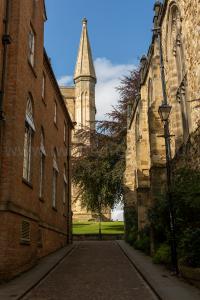
View of Bow Lane, Durham [Map] looking towards the Cathedral.
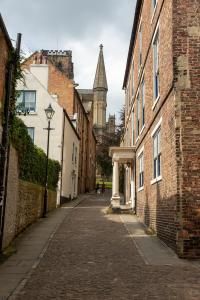
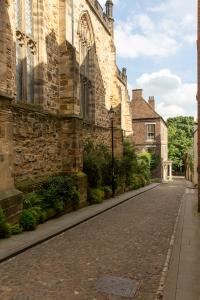
Europe, British Isles, North-East England, County Durham, Bridges in Durham
Europe, British Isles, North-East England, County Durham, Bridges in Durham, Framwellgate Bridge [Map]![]()
View of Framwellgate Bridge, Durham [Map] from Prebends Bridge, Durham.
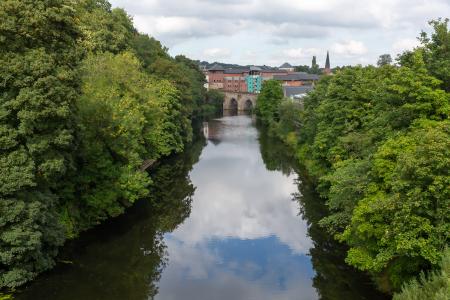
In 1318 Robert "Peacock of the North" Neville (age 31) murdered his cousin Robert FitzMarmaduke, Steward of Durham, on Framwellgate Bridge, Durham [Map].
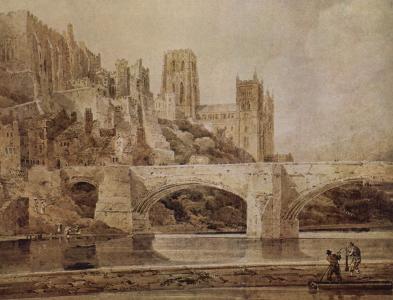 1799. Thomas Girtin (age 23). Durham Cathedral [Map] and Framwellgate Bridge, Durham [Map].
1799. Thomas Girtin (age 23). Durham Cathedral [Map] and Framwellgate Bridge, Durham [Map].
Europe, British Isles, North-East England, County Durham, Bridges in Durham, Kingsgate Bridge [Map]![]()
1963. Kingsgate Bridge, Durham [Map] over the River Wear designed by Ove Arup; the last structure he designed.
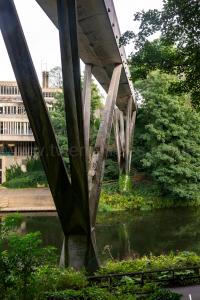
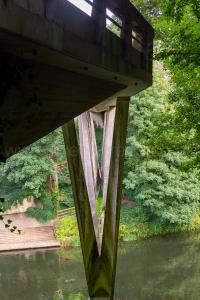
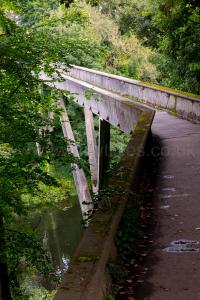
Durham Castle![]()
Flowers of History. 1071. In the same year, king William (age 43) invaded Scotland with a great army, and Malcolm, king of Scotland (age 39), came peaceably to Berwick [Map] to meet him, and became his subject. At this time, count Ranulph of Micenis governed the earldom of Carlisle, who had given efficacious assistance to king William in his conquest of England. He began to build the city of Carlisle [Map], and to strengthen the citizens with many privileges. But when king William was returning from Scotland through Cumberland, seeing so royal a city, he took it from count Ranulph, and gave him instead of it the earldom of Chester, which was endowed with many honours and privileges. And king William commanded Carlisle to be fortified with very strong towers and ramparts. Moreover, king William the Conqueror, on his return from Scotland, built a new castle at Durham [Map], to serve as a protection against the irruptions of the Scots.

1072. Construction of Durham Castle [Map] began in 1072 on the orders of King William "Conqueror" I of England (age 44). The construction took place under the supervision of Waltheof, Earl of Northumbria, until he rebelled against William and was executed in 1076. Bishop William Walcher was appointed by the king to exercise royal authority on his behalf, with the castle being his seat, and thus became the first of the Prince-Bishops of Durham, with the right to raise an army, mint his own coins, and levy taxes. As long as he remained loyal to the king of England, he could govern as a virtually autonomous ruler, reaping the revenue from his territory, but also remaining mindful of his role of protecting England's northern frontier.
Bishop William Walcher: Flowers of History. 1080. This year also, king William led a powerful army into Wales, and subjugated it; and received homage and hostages for their fidelity from the petty kings of the viscounty. The same year, Antioch was taken by the pagans, together with the adjacent province, which had been a Christian land ever since the time of Saint Peter, without any disturbances. The same year, Malcolm, king of Scotland, became furious a second time after the Assumption of the blessed Virgin Mary, and ravaged the whole of Northumberland, as far as the river Tyne. But when he heard of this, the king of England sent his son Robert with an army into Scotland, who returned without having succeeded in his objects, and built a new castle in the river Tyne, and then returned to his father. The same year also, the king sent his brother Odo, bishop of Bayeux, with a large army, to lay waste Northumberland, the people of which district had risen in insurrection against the king, and had murdered Walcher, bishop of Durham, a man of exemplary character, at Gateshead. In May 1080 Bishop William Walcher was killed when Durham Castle was besieged by rebels from Northumbria.
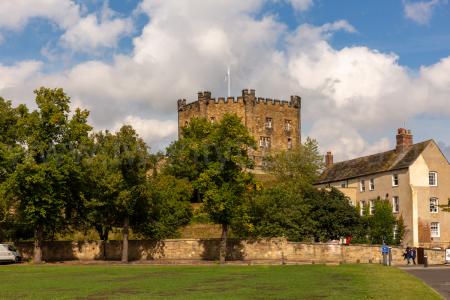
In May 1080 Bishop William Walcher was killed when Durham Castle [Map] was besieged by rebels from Northumbria.
In 1177 King Henry "Curtmantle" II of England (age 43) seized Durham Castle [Map] after a disagreement with the then-bishop, Bishop Hugh de Puiset (age 52).
In 1832 Bishop William van Mildert (age 66) gave Durham Castle [Map] and a large number of buildings on Palace Green, between the Castle and the Cathedral, as part of the foundation of Durham University. At the same time he arranged for the residence of the Bishop of Durham to be moved to Bishop Auckland, County Durham [Map].
The River Wear rises near Killhope, County Durham [Map] as the Killhope Burn from where it flows past Cowshill, County Durham [Map] and Wearhead, County Durham [Map] after which it is known as the River Wear.
Thereafter it flows past St John's Chapel, County Durham [Map], Westgate, County Durham [Map], Eastgate, County Durham [Map], Stanhope, County Durham [Map], Forsterley, County Durham [Map], Wolsingham, County Durham [Map], Witton-le-Wear, County Durham [Map], Bishop Auckland, County Durham [Map], Willington, County Durham [Map], Sunderland Bridge, County Durham through Durham forming a great loop overrlooked by the Castle [Map] and Cathedral [Map], past Chester-le-Street, County Durham [Map] and through Sunderland, County Durham [Map] where it joins the North Sea.
Europe, British Isles, North-East England, County Durham, Durham Marketplace
02 Dec 1861. Statue to Charles William Vane 3rd Marquess Londonderry in Durham Marketplace unveiled on 02 Dec 1861 in a ceremony involving the rifle volunteers of Seaham, Sunderland and Durham City. Among those in attendance was the future prime minister, Benjamin Disraeli (age 56). When the Marquis of Londonderry died in 1854, his widow set up a subscription committee to raise money for a statue of him. The artist commissioned was Rafaelle Monti (age 43).
Rafaelle Monti: In 1818 he was born in Milan. In 1881 he died.
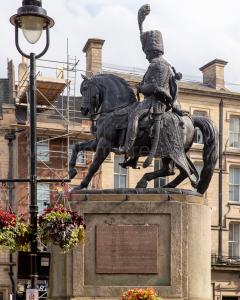
Europe, British Isles, North-East England, County Durham, Durham, Prebends Bridge
View of Framwellgate Bridge, Durham [Map] from Prebends Bridge, Durham.

Europe, British Isles, North-East England, County Durham, Durham, St Margaret's Church
On 15 Aug 1626 Bishop John Cosins (age 31) and Frances Blakiston were married at St Margaret's Church.
Europe, British Isles, North-East England, County Durham, Durham, The Counts House
. Built around 1820 by the Dean and Chapter of Durham Cathedral as a folly, the The Counts House, Durham is named after Polish 'Count' Joseph Boruwlaski which lived nearby in Callamanco Hall aka Banks Cottage.
